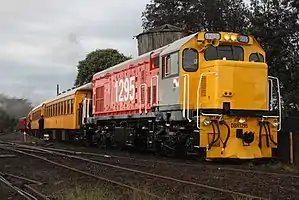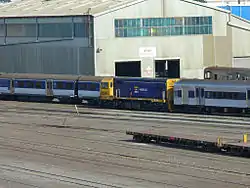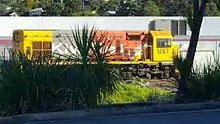New Zealand DB class locomotive
The New Zealand DB class and DBR class[nb 1] locomotive is a type of diesel-electric locomotive built for service on New Zealand's rail network. They were built by General Motors Diesel (GMD) of Canada as a narrow-gauge version of the EMD G8 model, with seventeen locomotives constructed. Ten of these were later rebuilt into the DBR class.
| New Zealand DB/DBR class | |||||||||||||||||||||||||||||
|---|---|---|---|---|---|---|---|---|---|---|---|---|---|---|---|---|---|---|---|---|---|---|---|---|---|---|---|---|---|
 GVR No.12 (DBR 1295) at Pukeoware Depot on the Glenbrook Vintage Railway | |||||||||||||||||||||||||||||
| |||||||||||||||||||||||||||||
| |||||||||||||||||||||||||||||
| |||||||||||||||||||||||||||||
| |||||||||||||||||||||||||||||
Introduction
The DB class was introduced to the rail network in 1965-1966 as a result of a requirement for a modern locomotive that could operate on the North Island lines that the DA class was excluded from due to their weight and axle load.[1][2] They were ordered at the same time as the final DA order was placed.[3][4] While these were mainly branch lines, it also applied to the East Coast Main Trunk line, particularly the section beyond Paeroa through the Karangahake and Athenree gorges until the opening of the Kaimai Tunnel in 1978.[5]
The class was virtually indistinguishable externally from the DA class, being of the same basic design and dimensions, and wearing the same livery. They were some 13 tonnes lighter with a V8 prime as opposed to a V12, though they shared the same A1A-A1A wheel configuration and traction motors for commonality with the DA fleet. The locomotives were supplied with cast-steel bogies manufactured by Dofasco, but these were swapped to Phase I DA class locomotives, which were delivered with fabricated bogies, once the DB class entered service.[4]
Numbering
The class was initially numbered DB 1000 to DB 1016, this being in common with NZR practice of the time to number locomotive classes with reference to the power output.
Upon the introduction of the computerised Traffic Monitoring System (TMS) in 1979 the class was renumbered and the designation capitalised. The class received new four-digit numbers beginning with 1, in which the last number is a check digit for the whole number. Under the new system DB 1001 retained its number, becoming DB 1001, with DB 1000 becoming DB1018. The rest of class was renumbered in sequence, with DB 1016 becoming DB1180.
The units being rebuilt to DBR received a new TMS number in the 12XX range when they entered the rebuilding cycle.
Rebuild to DBR

In the late 1970s the decision was undertaken to rebuild the DB class along similar lines to that being undertaken for the DA class into the DC class.[5] The rebuilt DB units were designated as DBR (R = rebuild). The work was undertaken by Clyde Engineering in Australia and involved the lowering of the short hood to improve visibility for the driver, new cabs and the installation of a new EMD 8-645 engine. Ten units were rebuilt between 1980 and 1982.[6][7]
In service
The DB class was employed primarily freight duties, though they did also see occasional service hauling passenger trains. As lines and bridges were upgraded, and in the case of the ECMT the Kaimai Tunnel opening, the weight advantage the locomotives had over other classes used in the North Island became less of a factor and the locomotives were operated as part of a general pool.
Initially, all DBR class locomotives were allocated to the North Island.[8] The lightweight nature of the DBR locomotives meant they were well suited to operate some South Island lines following the withdrawal of the DI and DJ class locomotives in the early 1990s.[6] The last DBR returned north from the South Island around 2007.[9]
Auckland Transport
From 2003[10] to 2014 two locomotives were leased to the Auckland Regional Transport Authority and then its successor, Auckland Transport, with the services operated under contract by Transdev. The two locomotives, DBRs 1199 and 1254 are operated in a top and tail configuration with the five car SX carriages set and wore the full MAXX Blue livery. A third unit, DBR 1226, was also painted in MAXX Blue but without the MAXX logo. DBR 1226 was usually used for freight services or work trains by KiwiRail but was used as back up for DBR 1199 or DBR 1254 as it had the necessary modifications to work with the suburban carriages. The leases expired in 2014 and the locomotives returned to freight service.[11]
Wellington bankers
For many years two DBR class locomotives formed the basis of a banker set out of Wellington, primarily assisting trains between Wellington and Paekakariki but also performing multiple other jobs including the Hutt Workshops shunt, work trains around the region and any unusual movements. DBRs 1199 and 1200 were the initial pair, becoming known as the "Bobsy Twins" (sp), likely a reference to the Bobbsey Twins due mainly to their consecutive numbers (a rarity under the TMS numbering system). In the early 2000s DBR1199 suffered a failure and was withdrawn from service and laid up, replaced on the banker set by DBR1267. DBR1199 was later sent to Hillside for repair and use on the Auckland SX set commuter trains, by which time the pairing of DBRs 1200 and 1267 had become known simply as "The Twins". DBR1267 was later transferred to Auckland to replace DBR1282,[12] with the Wellington banking role taken over by other locomotives.

Livery
The locomotives were delivered in the same overall deep red livery as the DA class, with the same white stripes along the sides and "wings" on the ends. With the introduction of TMS the locomotives road numbers were applied in large white numbers to the long hoods.
This livery was worn by many of the original DBs until their retirement, while the DBRs were returned to service in the International Orange or "Fruit Salad" scheme (red and grey with yellow safety ends) being applied to most NZR locomotive classes at the time. DBs 1082 and 1099 also received this livery in the 1980s.
DBR 1295 was repainted into the Toll Rail "Corn Cob" scheme (yellow and green), and the three units used on Auckland services have received the MAXX Blue livery (deep blue and yellow). More recently DBR 1267 has received the KiwiRail grey, red and yellow scheme.
Withdrawal and disposal

As of May 2017, all units have been withdrawn from service. The locomotives were withdrawn on account of being either surplus to requirements, or in poor mechanical condition. All of the DB locomotives were withdrawn by February 1989. In the early 2000s, DBRs 1199, 1239 and 1241 were withdrawn and placed into storage at Hutt Workshops.[13][14] DBR1199 was reinstated a year later for suburban trains in Auckland,[10][15] and 1239 and 1241 were scrapped at Hutt Workshops in February 2008.[16]
More withdrawals commenced in July 2013, with 1200 being the first.[17][18] A few more were laid-up over the next few months.[19][20] In February 2014, 1267, 1282 and 1295 were reinstated due to the DL class locomotives being taken out of service after samples from one locomotive tested positive for asbestos.[20][21] Withdrawals began again in May of that year when 1282 was laid up.[21][17] The rest have been withdrawn, with 1226 being the last.[22]
In June 2017, KiwiRail issued a Request for Quotation (RFQ) via the Government Electronic Tendering Service (GETS).[23][22] In August 2017, it was announced that DBRs 1254 and 1295 have been purchased by the Glenbrook Vintage Railway.[24][25] The remaining DBRs were originally sold to an locomotive/rolling stock dealer in South Africa,[25] but have now been sold to DBM Contracting.[24][26]
Preservation
In August 2017, it was announced by the Glenbrook Vintage Railway that they had purchased DBRs 1254 and 1295 for eventually hauling mainline excursions.[24][25] After being stored at Hutt Workshops, the pair arrived on-site on 3 November 2017.[26] In March 2018, 1295 was repainted in the "International Orange" livery.[27][28] In May 2018, work started on overhauling 1254 for mainline certification. Both have been given GVR numbers, which are No.11 and No.12 respectively.[29] DBR 1254's restoration was completed in September 2019, and is now mainline certified.[30]
References
Footnotes
- Following the introduction of TMS in 1979, the class classification was capitalised, whereas previously the second letter was a smaller capital letter, that is DB
Citations
- "Medium Powered Diesels for NZR Secondary Lines". Railway Transportation: 26,27. November 1965.
- "New Zealand Railways". Network: 2. August 1966.
- "More Diesels Ordered". New Zealand Railway Observer. New Zealand Railway and Locomotive Society. 21 (1): 31. Autumn 1964. ISSN 0028-8624.
- Palmer & Stewart 1965, p. 159.
- McClare 1980, p. 10.
- "Railfan". Vol. 2, no. 3. Triple M Publications. June 1996. ISSN 1173-2229.
- "Railfan". Vol. 8, no. 4. Triple M Publications. September 2002. ISSN 1173-2229.
- "NZR's locomotive fleet - where to from here?". Rails: 257. July 1990. ISSN 0110-6155.
- "DBR 1213 28/04/2007 Greymouth, NZ". Flickr. Retrieved 6 June 2017.
- "Railfan". Vol. 9, no. 3. Triple M Publications. June 2003. ISSN 1173-2229.
- "Railfan". Vol. 20, no. 4. Triple M Publications. September 2014. ISSN 1173-2229.
- "Railfan". Vol. 19, no. 2. Triple M Publications. March 2013. ISSN 1173-2229.
- "Railfan". Vol. 9, no. 1. Triple M Publications. December 2002. ISSN 1173-2229.
- "Railfan". Vol. 9, no. 2. Triple M Publications. March 2003. ISSN 1173-2229.
- "Railfan". Vol. 9, no. 4. Triple M Publications. September 2003. ISSN 1173-2229.
- "Railfan". Vol. 14, no. 2. Triple M Publications. March 2008. ISSN 1173-2229.
- "Withdrawn locomotives (Official Information Act request)". fyi.org.nz. KiwiRail. 29 July 2014. Retrieved 13 November 2017.
- "Railfan". Vol. 19, no. 4. Triple M Publications. September 2013. ISSN 1173-2229.
- "Railfan". Vol. 20, no. 1. Triple M Publications. December 2013. ISSN 1173-2229.
- "Railfan". Vol. 20, no. 2. Triple M Publications. March 2014. ISSN 1173-2229.
- "Railfan". Vol. 20, no. 3. Triple M Publications. June 2014. ISSN 1173-2229.
- "Railfan". Vol. 23, no. 3. Triple M Publications. June 2017. ISSN 1173-2229.
- "KiwiRail - Disposal of various DBR locomotives RFQ". 24 June 2017. Retrieved 24 June 2017.
- "Diesel Locomotives Register". New Zealand Rolling Stock Register. Retrieved 10 August 2017.
- "Railfan". Vol. 23, no. 4. Triple M Publications. September 2017. ISSN 1173-2229.
- "Railfan". Vol. 24, no. 1. Triple M Publications. December 2017. ISSN 1173-2229.
- "Railfan". Vol. 24, no. 3. Triple M Publications. June 2018. ISSN 1173-2229.
- "Railfan". Vol. 24, no. 3. Triple M Publications. September 2018. ISSN 1173-2229.
- "Glenbrook Vintage Railway - Locomotives". Archived from the original on 27 February 2020. Retrieved 28 January 2019.
- "New rail tours a boost to Ruapehu tourism". Whanganui Chronicle. 13 June 2021. Retrieved 14 November 2021.
Bibliography
- Alcock, Graeme (September 1998). "The DB class locomotive story". New Zealand Rail Fan. 4 (4): 34-54.
- McGavin, T A (1983). NZR Locomotives and Railcars 1983. Wellington, New Zealand: New Zealand Railway and Locomotive Society.
- McClare, E J (1980). New Zealand Railway Diesels. Wellington, New Zealand: Southern Press. ISBN 9780907769286.
- Palmer, A. N.; Stewart, W. W. (1965). Cavalcade of New Zealand Locomotives. Wellington: A H. & A W. Reed. ISBN 978-0-207-94500-7.
- Parsons, David (2002). New Zealand Railway Motive Power 2002. New Zealand Railway and Locomotive Society. p. 64. ISBN 978-0-908573-78-3. Archived from the original on 7 March 2007. Retrieved 25 February 2019.